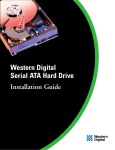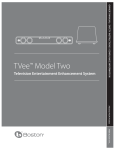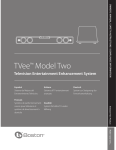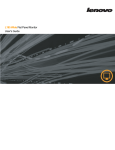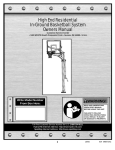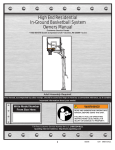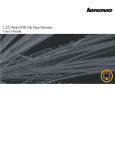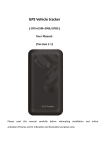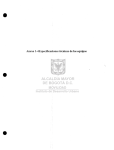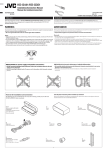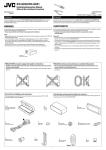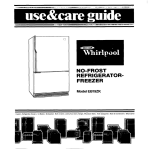Download Western Digital Caviar RE3, 1 TB, 1.2 million/h MTBF, 32 MB Cache, 7200 RPM
Transcript
Before Getting Started Necessary materials and tools: This poster is designed to aid in the quick installation of your WD SATA hard drive. If you experience problems following these procedures or need further information regarding your drive, visit support.wdc.com to search our online knowledge base for frequently asked questions and other common troubleshooting tips and to download the full version WD SATA Hard Drive Installation Guide. WD SATA Hard Drive Quick Install Guide Mou nting Screws WD SATA Hard Drive g ettin WD SATA Cable with SecureConne ct ™ Star l lem tal k insta prob quic ce ation Digi in theexperienr in form Western Digital ) . to aidIf you fu rthe version site at tern rmation are d e. Wes gned act act info system desi ha rd drivs or need the fullour Web ay cont cont intosh dure nt was e f rom m e for Digital roceve, downloa Guid . Or you k pag the Mac e. docume tern e p This Wes thesyour dri allational. com the bac s for back pag your wingrding e Inst digit (see u ction of the follo po rt instr rtion te rega Driv.western ion po Disket l Sup Hard www nica Installatthe top rd Tools Tech E: on Lifegua Data s s NOTlocated tent r Shunt ing Screw re G Computer system manual " Operating system manual " Operating system installation CD " Phillips and flat-blade screwdrivers (if applicable) 1. Before performing any hardware installation, back up your existing data. Kit Contents Befo " al D igit ern ve Westard D ri l l your H Insta ation ford rive Kit Con Mounta Jumpe and X S/M: WM XXXXXXX X MDL: WD XXXXXX X DCM: XXXXX Hard n Digital block) jumper Wester (10-pin Dri ve Hard s larger drive than 137 GB 2. Before handling the drive or system components, discharge static electricity by touching the metal chassis of your computer case or using an antistatic wrist strap. 3. Locate the WD serial number, model number, and date code on the label on top of your drive, and record them below. Serial Number: (for use only with WD S ATA hard d rives) e the includ fol Model Number: Ultra Ins ATA Card Ultra ller Contro ll k rd QuicHard watererninDistagital ha Date: Wes Unpacking and Handling Procedures ! ! Do not unpack your hard drive until you are ready to install it. Your hard drive is packaged in an anti-static bag. Handle the hard drive only by the sides. Avoid touching circuit board components on the bottom of the drive. To avoid ESD problems, ground yourself by touching the metal chassis of the computer or by wearing a grounding strap before handling the hard drive. Articles of clothing generate static electricity. Do not allow clothing to come in direct contact with the hard drive or circuit board components. ! Do not stack hard drives or stand your WD drive on its edge. ! Do not drop, shake, or knock down the hard drive. ! Save the original packaging materials and antistatic bag in case you need to return your hard drive. Your warranty will be void if your returned drive is shipped in anything other than the original packaging or WD-approved materials. (for WD 7200 RPM S ATA hard d rive kits) Operating Systems WD hard drives are precision instruments and must be handled with care during unpacking and installation. Hard drives can be damaged by rough handling, shock and vibration, or electrostatic discharge (ESD). Be aware of the following precautions: ! 4. Power down the computer and unplug the power cord. 5. Remove the system cover (refer to your system manual for instructions). Data Lifeguard Tools™ CD Docume ntation Technical Support If you need additional information or help during installation or normal use of this product, visit our product support Web site at support.wdc.com and choose from these topics: WARNING Using an operating system not listed below may result in data loss. " The following operating systems are supported: ! Windows® XP ! Windows 2000 " " System Requirements " ! ! SATA interface connector on motherboard, or SATA controller card (sold separately) installed in an available 32-bit PCI expansion slot (2.1- or 2.2-compliant). " 3.5-inch internal drive bay " Online Product Registration " Take advantage of WD offerings by registering your drive at https://www.westerndigital.com/en/products/registration. 1 " Warranty Services — Obtain warranty information, warranty status, extended warranty, product replacement, RMA status, and shipping and packaging information. Downloads Library — Download installation software and drivers. Technical Information — Access product specifications, technical tips, and the online forum. Knowledge Base — Explore our expert knowledge base and frequently asked questions (FAQs). Service Partners — Find available WD-approved service and support in your region. Contact Support — Contact a support representative by phone or e-mail. Rebates — Check the status of rebate submissions. Localized Support — Display service and support information in various languages. Set the Jumpers Note: WD SATA drives ship from the factory with either Default 1 or Default 2 (see below) set as the standard configuration. The default setting for WD SATA hard drives varies depending on the model. To determine the default setting for your drive, look at the drive label on the top of the drive. DO NOT change the default setting if you intend to use the drive in a desktop computer. Standard configuration 1 (no jumper added - spread spectrum clocking disabled). Default 1 Change the jumper settings ONLY if you intend to use the drive in an enterprise storage environment. For more information on these advanced settings, obtain the full version WD SATA Installation Guide at support.wdc.com. SSC_DIS Mode (Default) — Enable or disable the spread spectrum clocking feature. Default setting is disabled. Standard configuration 2 (jumper across pins 1-2 - spread spectrum clocking disabled). Default 2 Neutral storage placement. In this position, the jumper has no effect on hard drive operation. Spread spectrum clocking enabled. Spread spectrum clocking enabled. OPT1 — Only for factory use. SSC enabled OPT2 — Only for factory use. 2 SSC enabled SSC enabled Default 1 PM2 enabled Install the SATA Hard Drive IMPORTANT: Only for WD 7200 RPM SATA hard drive kits; all other WD SATA hard drive kits, skip to step 1 below. If installing your new WD drive as an upgrade from a previously installed hard drive: To ensure the optimal settings for your drive configuration, WD recommends running the Installation Tutorial in the Windows version of Data Lifeguard Tools before hardware installation to generate your custom installation instructions. See “Data Lifeguard Tools” on the reverse side of this poster. 1. Connect the smaller connector on the WD SATA cable to the SATA connector on the motherboard or SATA controller card. NOTE: If using a SATA controller card, be sure to follow the instructions that came with the card to install SATA host drivers. with SecureConnect 2. Attach the larger end of the WD SATA cable directly to the SATA interface on the back of the WD drive as shown above. SATA connectors are keyed to ensure proper insertion. Also attach the legacy 4-pin power connector. CAUTION Motherboard 5.25-inch Bay Hard Drives (in 3.5-inch Bay) Expansion Slot SATA Controller Card CD-ROM Drive SATA Connector on Controller Card Faceplate 3.5-inch Floppy Drive Power Supply SATA Motherboard Configuration SATA Controller Card Configuration The WD SATA cable with SecureConnect™ does not supply power to the drive. When using the WD SATA cable, you must also attach the legacy ATA 4-pin power connector to the SATA drive. When using a standard SATA interface cable (not included) instead, DO NOT connect both the standard SATA cable (not included) and legacy ATA 4-pin power cable at the same time or the drive may malfunction. 3. Slide the hard drive into an available 3.5-inch drive MOUNTING THE HARD DRIVE bay and secure the drive with the four mounting screws (two on each side). For proper grounding, install the screws in the hole positions as shown. 4. Verify all cable connections. Replace and secure the system cover. Reconnect the power cord and power up the computer. 5. If your WD SATA drive came with a Data Lifeguard Tools™ CD, see “Set Up Your Hard Drive” on the reverse side of this poster to set up your new hard drive. If your hard drive kit did not include a Data Lifeguard Tools CD, see “Alternate Instructions for Installing a Drive” on the reverse side of this poster. 3 Create a Bootable Diskette Using Data Lifeguard Tools Follow these steps to create a bootable diskette using Data Lifeguard Tools: 1. Insert the Data Lifeguard Tools CD into your CD-ROM drive. IMPORTANT: If your hard drive kit does not include a Data Lifeguard Tools CD, skip to “Alternate Instructions for Installing a Drive (Windows XP/2000).” You can also obtain the latest version of Data Lifeguard Tools from our Web site at support.wdc.com. a. If using the Windows version, the CD autoruns on your desktop. b. If using the DOS version, restart the computer and boot from the CD. WD’s Data Lifeguard Tools assists with hard drive installation, management, and diagnostics. Depending on your setup and configuration, you can use either the Windows or DOS version of Data Lifeguard Tools. 2. When the autorun menu appears, select Create a Data Lifeguard Bootable Installation Diskette. Follow the directions as prompted. NOTE: Windows and DOS versions of Data Lifeguard Tools may vary slightly from one another in text, graphic placement, or color. Follow these steps to create and print custom hardware installation instructions: NOTE: The model number of your hard drive is printed on the label on top of the drive. Data Lifeguard Tools contents: 1. Insert the Data Lifeguard Tools CD into your CD-ROM drive. ! Create a Bootable Diskette — Create a bootable diskette in seconds. ! View Installation Tutorial — Create, view, and print a customized installation manual. ! Set Up Your Hard Drive — Partition and format an installed hard drive. ! ! ! Drive-to-Drive Copy — Copy all the files or a specific folder from one hard drive to another; set a specific hard drive size. Hard Drive Information — Configure jumper settings and other technical information regarding your hard drive. Register Your Hard Drive — Register your hard drive online (Internet connection required). Set Up Your Hard Drive This section contains instructions for installing your new WD hard drive either as a new boot drive or as an additional storage drive. Install a New Boot Drive 1. Insert the Data Lifeguard Tools CD into your CD-ROM drive. a. If using the Windows version, the CD autoruns on your desktop. View Installation Tutorial a. If using the Windows version, the CD autoruns on your desktop. b. If using the DOS version, restart the computer and boot from the CD. 2. Select View Installation Tutorial from the setup menu. 3. Depending on whether you run the Windows or DOS version, Data Lifeguard Tools may prompt you to select your model number or a hard drive configuration. If your hard drive is not listed, you can manually type in the model number. Follow the instructions as prompted to create your custom instructions. 4. If using the Windows version, your default Web browser opens automatically and displays your custom instructions. If using the DOS version, your instructions are displayed in the window. Click Next to print the instructions. 7. The next screen outlines your setup options, number of partitions, file format, and the size of each partition. Data Lifeguard Tools is now ready to set up your new hard drive. Click Erase then Next to continue. CAUTION: All existing data on the hard drive will be erased. If you are prompted to continue, click Yes to proceed. 8. After Data Lifeguard Tools completes formatting and partitioning the drive, the setup summary screen below outlines all steps completed. Click Done to exit. b. If using the DOS version, restart the computer and boot from the CD. 2. Select Run Data Lifeguard Installation Software from the autorun setup menu. 3. The main menu (shown below) appears after Data Lifeguard Tools is loaded. Click Set Up Your Hard Drive from the list of options. Data Lifeguard™ may take several moments to scan for system devices. 4. After detecting your installed hard drives, select the drive to be formatted or partitioned as additional storage and click Next. If you are using a SATA controller card, click the Additional Controllers tab to select your new drive. 5. For Installation Type, select Add the drive as an additional device. To create customized partitions, select the box to change advanced options and check Custom Partition. 6. The Custom Partition Setup screen (shown below) appears. Your hard drive is automatically partitioned to the largest capacity up to 137 GB based on your operating system limitations. If the drive contains existing partitions and you want to create or add partitions, you must first click Delete to remove existing partitions. To add partitions, use the slider bar to set the desired partition size, then click Add Partition. After configuring the partitions, click Next. 9. Remove the Data Lifeguard Tools CD from the CD-ROM drive and choose from the following options: a. If installing Windows, insert the Windows installation CD in the CD-ROM drive and restart the system. Follow the on-screen instructions to install the operating system. b. If an operating system is already been installed, restart the system. 4. After Data Lifeguard Tools detects your installed hard drive(s), select the new drive to be formatted or partitioned as the new boot drive and click Next. If you are using a SATA controller card, click the Additional Controllers tab to select your new drive. NOTE: Data Lifeguard Tools does not format or partition a currently installed boot drive (the drive icon is disabled). 5. For Installation Type, select Add the drive as a boot device. To create customized partitions, select the box to change advanced options and check Custom Partition. 6. The Custom Partition Setup screen appears. Your hard drive is automatically partitioned to the largest capacity based on your operating system limitations. If the drive contains existing partitions and you want to create or add partitions, you must first click Delete to remove existing partitions. To add partitions, use the slider bar to size the partition, then click Add Partition. After setting the partitions, click Next. Drive-to-Drive Copy CAUTION Both source and destination hard drives must be formatted and partitioned before using this utility. Follow the instructions above to set up your drive. The Drive-to-Drive Copy utility copies files from one drive to another. Use this feature when replacing an existing boot hard drive with a newer, faster hard drive. 1. Insert the Data Lifeguard Tools CD into your CD-ROM drive. Select Drive-to-Drive Copy from the main menu. 2. Select the Source and Destination paths with the selected folders. You can click Browse to easily access folders or files on both hard drives. NOTE: Existing files on the destination drive are overwritten if there are files on the source drive with the same name. 3. After selecting the folder for each path, click Start to begin copying. The progress bar for the current file being copied and overall progress is displayed. 4. When copying is completed, click OK to display the results summary. Click Done to exit Data Lifeguard Tools. 5. Remove the CD and restart the computer to use your new WD hard drive. This concludes the hard drive setup process. Your WD SATA hard drive is now ready to use. Install an Additional Storage Drive 1. Insert the Data Lifeguard Tools CD into your CD-ROM drive. a. If using the Windows version, the CD autoruns on your desktop. b. If using the DOS version, restart the computer and boot from the CD. 2. Select Run Data Lifeguard Installation Software from the setup menu. 3. The main menu appears after Data Lifeguard Tools is loaded. Click Set Up Your Hard Drive from the list of options. Data Lifeguard Tools may take several moments to scan for system devices. Hard Drive Information This feature allows you to view the drive model number, serial number, capacity, UDMA mode, and other details about your WD SATA hard drive. 1. Insert the Data Lifeguard Tools CD into your CD-ROM drive. Select Hard Drive Information from the main menu. 2. In the next window, you are given options to select either View Hard Drive Information or View Jumper Settings. 7. The next screen outlines your setup options, number of partitions, file format, and the size of each partition. Data Lifeguard Tools is now ready to set up your new hard drive. Click Erase, then Next. CAUTION: Continuing will erase all existing data on the hard drive. If you are certain, click Yes to proceed with format and partition. 8. After Data Lifeguard Tools completes formatting and partitioning the drive, the setup summary screen outlines all steps completed. Click Done to exit. 9. Remove the CD from the CD-ROM drive to begin using your new WD hard drive as additional storage. A new drive letter and icon appear under My Computer. This concludes the hard drive setup process. Your WD SATA hard drive is now ready to use. Alternate Alternate Instructions Instructions for for Installing Installing Aa Drive (Windows XP/2000) IfIfyour yourhard harddrive drivekit kitdid does notnot include include a Data a Data Lifeguard Lifeguard Tools Tools CD,CD, youyou can use canWindow’s use Windows built-in built-in Disk Disk Management Management utilityutility to format to format and partition and your partition drive.your If necessary, drive. If necessary, refer to your refer operating to your operating system manual systemfor detailed manual for instructions. detailed instructions. Install Install aa Single Single Hard Hard Drive: Drive 1.1. Boot Bootto from thethe Windows Windows XP XP or Windows or Windows 20002000 Installation Installation CD.CD. 2.2. Follow Followthe thedirections directionsinasthe prompted. installation prompt. a. View Hard Drive Information — Once your drive is detected, click the tab for either Partition Table or SATA Information to display information about the drive format, LBA support, DMA support, firmware revision, etc. Install Install an an Additional Additional Hard Hard Drive: Drive b. View Jumper Settings — Select the drive model number and configuration, then click View Jumper Settings to display the selected jumper setting diagram in your default Web browser. 2.2. Double-click Double-clickon thethe Computer Computer Management Management icon icon and and select select Disk Disk Management Managementon onthe theleft leftside. side. 3.3. Right-click Right-clickon your your new new hard hard drive drive to and proceed proceed withwith partitioning partitioning and and formatting. formatting. Windows WindowsXP XP 1.1. Click Clickthe theStart Startbutton buttonand andpoint pointto toControl ControlPanel Panel>>Performance Performanceand and Maintenance Maintenance>>Administrative AdministrativeTools. Tools. Windows Windows2000 2000 1.1. Click Clickthe theStart Startbutton buttonand andpoint pointto toSettings Settings>>Control ControlPanel Panel>> Administrative AdministrativeTools. Tools. 2.2. Double-click Double-clickon thethe Computer Computer Management Management icon icon and and select select Disk Disk Management Managementon onthe theleft leftside. side. 3.3. Right-click Right-clickon your your new new hard hard drive drive to to proceed proceed with with partitioning partitioning and and formatting. formatting. © 2005 Western Digital Technologies, Inc. All rights reserved. Western Digital is a registered trademark; and WD, the WD logo, Data Lifeguard, Data Lifeguard Tools, and SecureConnect are trademarks of Western Digital Technologies, Inc. Other marks may be mentioned herein that belong to other companies. Specifications subject to change without notice. 2079-001042-A06 07/05


